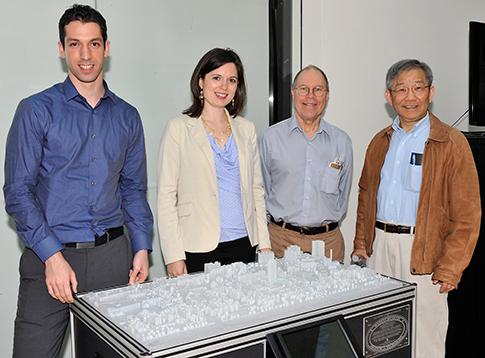Students and researchers lit up their own version of MIT recently with a triumvirate of technology and analysis, making science look awfully fun in the process.
 Just check out LuminoCity, which was created using the technology of 3D printing, combined with Big Data analysis of the Twitter DecaHose, and CLAIRITY—an air quality monitoring network. 3D printing ended up playing a comprehensive role in tying the whole project together—and demonstrating the knowledge of all involved.
Just check out LuminoCity, which was created using the technology of 3D printing, combined with Big Data analysis of the Twitter DecaHose, and CLAIRITY—an air quality monitoring network. 3D printing ended up playing a comprehensive role in tying the whole project together—and demonstrating the knowledge of all involved.
LuminoCity was created by MIT’s Lincoln Laboratories researchers Vijay Gadepally and Zachary Weber. They decked out their 3D model campus with Twitter Decahose, an analystics tool which Twitter has teamed up and released with social media data provider Gnip.
Using LuminoCity as a tool to project geotagged data points up through the bottom of the model, the researchers are able to illuminate large amounts of ‘geodata,’ of which the Twitter data is a good example: someone tweets their message with say, info regarding a traffic jam, and their location is given at the same time. With this tool, researchers would be able to use the big data to identify traffic clusters, problems, and be able to use something like the 3D printed LuminoCity model to observe, confer, and plan.
The big data analysis tool, coupled with LuminoCity could be used in multiple applications, but the traffic example is one that may be put into use soon. While many individuals worry about their privacy being invaded through social media in terms of information and location, the upside to contributing that information is that in these applications it is helpful.

Lincoln Laboratory mentors for the spring course, left to right, Theo Tsiligkaridis, Danelle Shah, Loren Wood, and Jen King Jao. Absent from the photo is Ken Mawhinney.
The 3D printed LumioCity, showing its versatility and usefulness in other areas, was gifted by the Lincoln Labs semester mentors to students at MIT Department of Civil and Environmental Engineering in helping to demonstrate a large-scale project called CLAIRITY, a sophisticated network of sensors (built with 3D printed housing) used to measure levels of gases and particulates around the MIT campus.
For LuminoCity, the students and researchers installed a group of sensors and a computer interface that lit up nodes, according to data—like air quality. Spotlighting not only their creativity, but also the knowledge they had gained, the students were able to share this information through ‘information visualization.’ CLAIRITY drives the 3D printed LuminoCity nonstop through a wifi connection, while the actual CLAIRITY network on campus has 24 indoor and outdoor sensor nodes that continuously measure gases and the small particles found in air pollution and send this data via wifi to the central computer.
While big data continues to grow at an enormous rate, so do the innovations and uses for 3D printing. Mixing the two sciences to produce relevant data combined with information visualization in the form of 3D printed models was bound to happen. Being able to view data using tangible 3D models makes it easier for scientists, engineers, and planners to observe patterns–and in the future, troubleshoot problem areas for elements such as sensor systems in city infrastructures.
Building miniature models of many different objects—airplanes, homes, cities, and more has been a hobby of enthusiasts through the ages. Introducing 3D printing into the quotient is not only a logical progression, but a truly efficient tool to maximize craftsmanship, as well as ease in making changes. 3D printed representation of data, for example—a traffic issue, can be worked out more quickly as a team effort when there is a problem requiring resolution. Have you built a 3D printed model of a community or city? Tell us about it in the MIT big data forum thread at 3DPB.com.
[Source: Arxiv.org]
Subscribe to Our Email Newsletter
Stay up-to-date on all the latest news from the 3D printing industry and receive information and offers from third party vendors.
You May Also Like
3D Printing Unpeeled: New Arkema Material for HP, Saddle and Macro MEMS
A new Arkema material for MJF is said to reduce costs per part by up to 25% and have an 85% reusability ratio. HP 3D HR PA 12 S has been...
3D Printing News Briefs, January 20, 2024: FDM, LPBF, Underwater 3D Printer, Racing, & More
We’re starting off with a process certification in today’s 3D Printing News Briefs, and then moving on to research about solute trapping, laser powder bed fusion, and then moving on...
3D Printing Webinar and Event Roundup: December 3, 2023
We’ve got plenty of events and webinars coming up for you this week! Quickparts is having a Manufacturing Roadshow, America Makes is holding a Member Town Hall, Stratafest makes two...
Formnext 2023 Day Three: Slam Dunk
I’m high—high on trade show. I’ve met numerous new faces and reconnected with old friends, creating an absolutely wonderful atmosphere. The excitement is palpable over several emerging developments. The high...
































